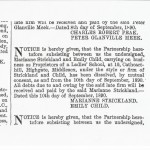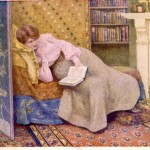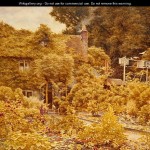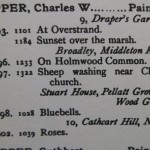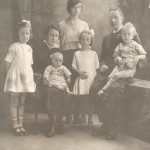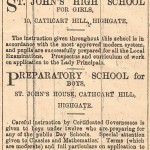
Holloway Press, 1889. The reference to ‘the Lady Principals’ shows that Mr & Mrs Thomas had moved on.
ST. JOHN’S HIGH SCHOOL FOR GIRLS , 10 Cathcart Hill, c. 1886-1895
Founded by schoolteacher Ferdinand John Thomas and Ruth Elizabeth Steel following their marriage of 1886, St. John’s was to have three different owners during its nine year existence. Little is known about German born Ferdinand and his wife, Ruth, other than that they were in Bristol on the 1881 Census and claiming to be husband and wife a full five years ahead of their marriage. Ferdinand was listed as ‘tutor’. It is possible that Ferdinand obtained a teaching position in Hastings as this is where their marriage took place. Having founded and run St. John’s for three years, Mr and Mrs F. J. Thomas moved to Bloomsbury in 1889, and on the 1891 Census for 6 Bedford Place Ferdinand is listed as ‘teacher of languages’ and Ruth as ‘lodging house keeper’.
St. John’s new co-principals were Marianne Strickland and Emily Child. Miss Strickland had for many years successfully run a much larger establishment, Parkfield College, in Sydenham. In 1886 Marianne sold the ‘goodwill’ of Parkfield College to a Madame Sophia Brodbeck, returning to her home town of York and opening a new school, Oxford House. Madame Brodbeck soon began legal proceedings against Miss Strickland claiming that Parkfield’s potential profits had been greatly misrepresented. The subsequent Chancery Court ruling against Marianne precipitated her bankruptcy in York in 1888, the year in which she was also to lose her only brother and sister. Yet by mid-1889 Miss Strickland was back in London and running St. John’s with the assistance of Mrs Child. This was a brief partnership, for, as announced in the London Gazette (see left), Emily Child departed in September 1890. 7 months later in the 1891 Census Miss Strickland is somehow managing to squeeze 29 staff and pupils into St. John’s 15 rooms*. Miss Strickland also offered a preparatory school for boys, St John’s House (see advertisement). This was not (as its title might suggest) a separate building, but merely a school within a school – perhaps even just one or two rooms. Hence, in 1891, the youngest of the pupils was in fact a little boy, William Hesseltine. William was killed in action in France in 1916.
It is not known what happened to Marianne Strickland following her departure in 1892. Her niece, Blanche Elizabeth Strickland who had boarded at both Parkfield College in Sydenham, Oxford House in York and at St. John’s in Cathcart Hill was to secure a position as a governess to the Flouch family of Bordeaux, later marrying one of the Flouch sons. It is possible that Marianne joined them in France and perhaps even died there.
According to local directories St. John’s third and final owner was ‘Mrs Alexander S. Kroenig’ ( as was the style then). Mrs Kroenig was in fact the recently wed Sarah Anne Atkinson. Sarah Anne was born in Lincoln in 1867 but we have been unable to establish with any certainty who her family were. In February 1892 she married Alexander Solomon Kroenig at St. Barnabas Church in Hull. Officiating at the ceremony was Alexander’s father, the Rev. Joshua Charles Solomon Kroenig, a German who had converted from Judaism and settled in Hull. Having taken on the running of St. John’s the Kroenigs went on to have two children and it is their births that offer a clue as to when St. John’s High School for Girls finally closed. Alex was born in 1894 and his birth was registered in the borough of Islington, whilst their daughter Ellen’s birth was registered in St Pancras, and it is known that the Kroenig’s next address, which was a beautiful house called ‘The Gothic’ on Highgate Road, lay within that borough. So it seems that St. John’s must have closed its doors some time between the years 1894 and 1895. Following their move to The Gothic Alexander S. Kroenig was himself ordained in December 1896 and obtained the Curacy of Kentish Town Parish Church.
CHARLES WILLIAM HOPPER , 10 Cathcart Hill, c.1901 – 05
Born in Rochdale in 1868, Charles William Hopper and his five brothers and sisters came to London where the family settled in Tottenham . Charles followed in his father’s footsteps and became a ‘stock jobbers clerk’. These acted as go-between agents for the brokers on the stock exchange floor. In 1901 Charles married Agnes Emily Richardson, an artist, who had been living in Pemberton Road with her brother and two sisters. The newly weds moved into No.10 and it is thought that they were at that address until 1904/5 . Nothing is known of Agnes’s artistic abilities (we are not aware of any artworks) but, as these two examples show, Charles showed himself to be a skilled watercolourist, displaying much sensitivity in his work, some of which was exhibited at the Royal Academy and at the Stock Exchange Art Society exhibitions, By the 1911 Census Charles and Agnes were living on The Broadway, Winchmore Hill in North London. Little is known of their lives beyond this other than that Charles continued to exhibit at the Stock Exchange at least into the 1920s and that his pieces were well received. Agnes died in 1942 in Barnet, her brother John administering her Will, whilst it is thought that Charles died in 1944 in London.
“Exhibited at the Stock Exchange Art Society ca: 1907. OLD MORTIBOY’S COTTAGE, Charles W. Hopper Exhibitor. R.A. Price £10. 10. 0′ (on an old label attached to the reverse) watercolour with scratching out 9¼ x 13 in. (23.5 x 33 cm.) Provenance Merton Russell Cotes, 1904.”
Lot Notes: “Charles W. Hopper lived in London and exhibited at the Royal Academy between 1893 and 1902. His works include On Holmwood Common, Sheep washing near Christchurch and Bluebells. This picture is of a cottage garden in Winchmore Hill, near Enfield, north London.”
Sold at Christie’s in 2007 for £2170. .
This comprehensive catalogue by Algernon Graves states that Charles W. Hopper’s composition “Roses” was exhibited at the Royal Academy in 1902 and that he was living at 10 Cathcart Hill at that time. This gives a useful clue as to when Charles and Agnes moved to Cathcart Hill because on the census of April 1901 No.10 had been listed as uninhabited.
